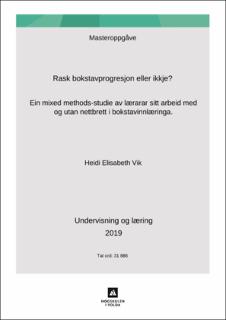| dc.contributor.advisor | Rogne, Wenke Mork | |
| dc.contributor.author | Vik, Heidi Elisabeth | |
| dc.coverage.spatial | Norway | en |
| dc.date.accessioned | 2020-03-02T08:58:24Z | |
| dc.date.available | 2020-03-02T08:58:24Z | |
| dc.date.issued | 2019 | |
| dc.identifier.uri | http://hdl.handle.net/11250/2644543 | |
| dc.description.abstract | Samandrag
Temaet for denne studien er bokstavinnlæring og korleis nokre førsteklasselærarar arbeider med dette. Eg ønskjer å finne ut kva slags utbreiing rask bokstavprogresjon har blant eit utval lærarar. Vidare ønskjer eg å finne ut korleis lærarane introduserer ein ny bokstav og kva slags skriveverktøy lærarane bruker i elevane si bokstavinnlæring. I tillegg til dette, vil eg undersøke kva slags uttalte tankar og erfaringar to lærarar har med å arbeide med rask bokstavprogresjon med og utan nettbrett.
Problemstillinga er: Kva slags utbreiing har rask bokstavprogresjon blant eit utval lærarar, og kva slags arbeidsmetodar og skriveverktøy nyttar lærarane i bokstavinnlæringa i første klasse?
Eg har nytta meg av eit sekvensielt forklarande mixed methods-design, der ei kvantitativ spørjeundersøking og to kvalitative intervju vert brukt som metode.
Spørjeundersøkinga er del av DigiHand-prosjektet sitt spørjeskjema og er utarbeida av forskarar frå Høgskulen i Volda og Universitet i Stavanger. Spørjeundersøkinga vart svart av 32 lærarar.
Eg plukka meg ut nokre spørsmål frå spørjeskjemaet som er relevant for problemstillinga, og desse analyserte eg vidare med deskriptiv statistikk og frekvensanalyser. I tillegg til dette, gjennomførte eg kvalitative intervju med to deltakarar i DigiHand-prosjektet. Spørsmåla i desse intervjua er basert på spørsmål frå DigiHand si spørjeundersøking, men går i tillegg meir i djupna på desse, samt utvidar desse noko.
Resultata frå både den kvantitative og kvalitative datainnsamlinga og analysen viser at mange av lærarane bruker ein rask bokstavprogresjon. Blant dei 32 lærarane som svarte på spørjeundersøkinga, er det 27 lærarar (84,4%) som bruker rask bokstavprogresjon. Dei to lærarane i dei kvalitative intervjua bruker også rask bokstavprogresjon, men har ulike erfaringar når det gjeld å arbeide med rask bokstavprogresjon. Vidare ser ein av resultata at lærarane i utvala bruker mykje samanfallande metodar når ein ny bokstav vert introdusert.
Når det gjeld kva slags skriveverktøy elevane til lærarane nyttar i bokstavinnlæringa, viser resultata at det varierer om elevane har 1:1-nettbrett eller datamaskin i bokstavinnlæringa og om dei lærer seg handskrift frå starten av første klasse eller om handskrifta er utsett. Dei to lærarane eg intervjua fortalte at elevane deira har 1:1-nettbrett og at bruken av nettbrett gjer det lettare å tilpasse opplæringa til elevane og å motivere dei for læring. | nn_NO |
| dc.description.abstract | Abstract
The theme for this study is letter learning and how a selection of first grade teachers is working accordingly. I want to find out what prevalence fast letter progression has among a selection of teachers. Furthermore, I want to find out how the teachers introduce a new letter and what writing tools the teachers use in connection with the pupils’ letter learning. In addition to this, I want to explore what stated thoughts and experiences two teachers have in connection with fast letter progression, with or without tablet.
The research question for the thesis is: What prevalence has fast letter progression among a selection of teachers, and what working methods and writing tools do the teachers use in the letter learning in first grade?
I have used an Explanatory Sequential Mixed Methods-Design, where a quantitative survey and two qualitative interviews were used as methods.
The survey is part of the DigiHand project questionnaire and is developed by researchers at the College of Volda and the University of Stavanger. 32 teachers answered the survey.
I have selected some questions from the questionnaire, which are relevant to this study. I analysed these questions further with descriptive statistics and frequency analyses. In addition to this, I conducted qualitative interviews with two participants in the DigiHand-project. The questions in these interviews were based on the questions from the DigiHand survey, but goes in addition further in depth, and also expand these questions.
The results from both the quantitative and qualitative data collection and analyses shows that many of the teachers are using fast letter progression. Among the 32 teachers that answered the survey, there are 27 teachers (84,4%) that use fast letter progression. The two teachers who were part of the qualitative interviews also use fast letter progression, but have different experiences concerning working with this. Further, we see from the results that the teachers use many consistent methods when a new letter is being introduced.
Concerning the writing tools the teachers use in connection with letter learning, the results shows that it varies if the pupils have 1:1-tablet or computers in the letter learning, and if the pupils learns handwriting from first grade or if the handwriting is postponed. The two teachers I interviewed told that their pupils have 1:1-tablet and that the usage of tablets makes it easier to adapt the pupils’ education and to motivate them for learning | en |
| dc.language.iso | nno | |
| dc.publisher | Høgskulen i Volda | nn_NO |
| dc.subject | DigiHand | en |
| dc.title | Rask bokstavprogresjon eller ikkje? Ein mixed methods-studie av lærarar sitt arbeid med og utan nettbrett i bokstavinnlæringa | nn_NO |
| dc.title.alternative | Kva slags utbreiing har rask bokstavprogresjon blant eit utval lærarar, og kva slags arbeidsmetodar og skriveverktøy nyttar lærarane i bokstavinnlæringa i første klasse? | nn_NO |
| dc.type | Master thesis | en |
| dc.rights.holder | forfattaren | nn_NO |
| dc.subject.nsi | VDP::Humaniora: 000::Språkvitenskapelige fag: 010::Anvendt språkvitenskap: 012 | nb_NO |
| dc.source.pagenumber | 104 | |
| dc.relation.project | NSD 188025 | |
| dc.relation.project | NFR 59799 | |
